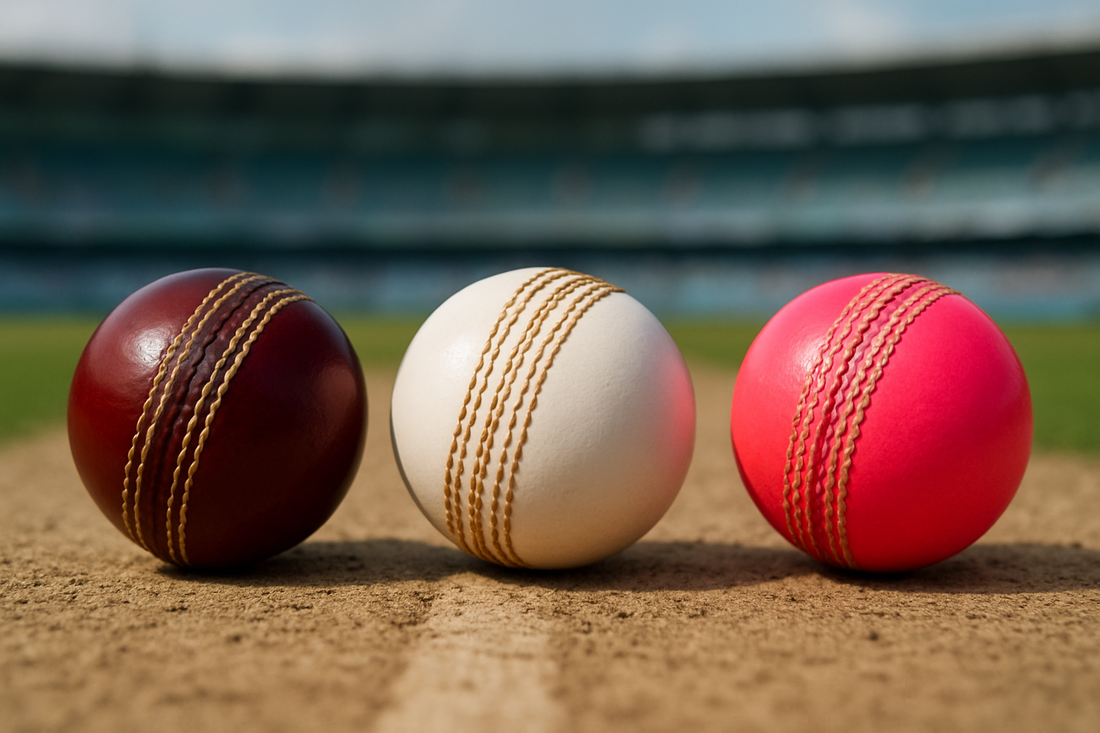
Red vs White vs Pink Cricket Balls (2025): Differences, Swing, Visibility & Durability
Share
The main difference between red, white, and pink cricket balls lies in format, visibility, and durability. Red balls last longest and are used in Tests, white balls swing early but wear quickly in ODIs/T20s, while pink balls balance visibility and movement for day-night Tests.
Cricket is often called a game of fine margins—small details can change a match. One of the most important of those details is the type of cricket ball being used. Whether it’s the traditional red, the modern white, or the innovative pink, each ball behaves differently and shapes how the game unfolds.
The Red Cricket Ball – Tradition Meets Endurance

The red cricket ball has been the heartbeat of Test Cricket for more than a century. Its darker dye and natural lacquer make it more durable than other types. Red balls keep their shine longer, letting bowlers use swing well into the innings.
- Durability: Can last up to 80–90 overs with proper maintenance.
- Swing: Supports both conventional and reverse swing.
- Best For: Long formats played in daylight.
This is why red balls remain the standard in Tests—they withstand hours of play and multiple spells from both pace and spin bowlers.
The White Cricket Ball – Powering Limited Overs

The white cricket ball rose with the popularity of day-night ODIs and T20s. It’s designed for high visibility under floodlights and against coloured jerseys—but it trades off durability.
- Swing: Moves more dramatically in the first 10 overs.
- Durability: Softer leather means quicker wear; ODIs even use two new balls (one from each end).
- Best For: ODIs and T20 matches under lights.
For batters, once the shine fades, stroke play becomes easier. For bowlers, the challenge is to strike early. This explains the difference between white and red ball cricket—white balls are made for shorter formats, while red balls endure the grind of Tests.
The Pink Cricket Ball – The Newcomer

The pink cricket ball was introduced to make day-night Test cricket possible. Red was hard to see at night; white clashed with whites. Pink offers the middle ground.
- Visibility: Clearer than red at night, while still working with traditional whites.
- Swing: Extra lacquer often means more movement—especially at dusk.
- Best For: Day-night Tests where conditions shift across light changes.
Many players say the pink ball behaves unpredictably during twilight—part of the challenge and the drama. This is why pink ball used in cricket is still a hot topic of debate among players and fans.
Why Do They Behave Differently?
The secret lies in how each ball is made:
- Leather dye & treatment → affects durability and visibility.
- Lacquer layers → control swing and shine retention.
- Format demands → Tests need endurance; ODIs/T20s need high visibility.
In short, the red vs pink ball vs white ball debate comes down to science + format needs.
FAQs: Red, White & Pink Cricket Balls
Q1. What is white ball cricket?
White ball cricket refers to ODIs and T20s, where white balls are used for visibility under lights.
Q2. Why are red balls used in Tests?
Because they last longer, retain shine, and remain visible in daylight.
Q3. Why do white balls lose shine faster?
The bleaching process makes the leather softer, so white balls wear down quicker.
Q4. Why were pink balls introduced?
To make Test cricket viable under lights—balancing visibility and performance.
Q5. Which swings more: red ball vs pink ball?
Both swing significantly, but pink often moves more at dusk due to the extra lacquer.
Final Thoughts
From the endurance of the red ball, to the early drama of the white ball, and the innovation of the pink, each cricket ball type has reshaped the game in its own way. The next time you watch a match, pay attention to the ball—it might explain the swings of momentum.

